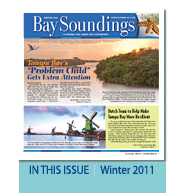 |
||||||||
“Living Laboratory” Opens at Stewart Middle School

Photo: Stephanie Powers, Southwest Florida Water Management District
Before: Invasive lead trees and a steep drop-off made it nearly impossible for students to reach the river.

Photo: Victoria Parsons
After: The sloping shoreline sculpted at Stewart contrasts with the hardened shoreline just down the river. Students planted native trees, shrubs and wildflowers that filter stormwater runoff and will use the shoreline as a “living laboratory” to track water quality and wildlife recruitment.
A strip of riverfront once covered in invasive plants has been transformed to a living laboratory by students from Stewart Middle School in a collaborative effort with public and private partners.
Located just north of downtown Tampa on the banks of the Hillsborough River, Stewart is a magnet school for science, engineering and technology, with a special focus on maritime issues. Their riverfront, however, was difficult to reach with a tangle of invasive lead trees abruptly ending with a steep drop-off to the water’s surface.
Stewart science teacher Lynn McDaniels had a different vision for the 1500-foot strip. She began building a team of volunteers and environmental professionals nearly a decade ago to help make the transformation possible:
- Alan Wright, now deceased, was a planner with the Hillsborough County Planning Commission known as “Mr. River”
- Sally Thompson, then a member of the Southwest Florida Water Management District’s governing board
- Jennette Seachrist, program manager for the district’s Surface Water Improvement and Management (SWIM) program
- Tom Ries, president of the not-for-profit Ecosphere Restoration Institute
- Candy Olsen, Hillsborough County school board member.
In a collaborative effort, the multiple groups came together to develop the $500,000 project with funding through the water management and school districts as well as Pinellas County Environmental Fund and Wheelabrator McKay Bay. “They had the vision to see something that other people might not be able to see,” McDaniels said.
Now, instead of a maze of invasive plants, the river is bordered with wildflowers, cordgrass, Walter’s viburnum, mangroves and other native plants that provide habitat for juvenile fish and crabs as well as birds and other land creatures.
Alex Samaras, assistant principal
The restored site includes an innovative plastic retaining wall with honeycomb sections where plants are installed, said Ries, who served as the project’s manager. “It also allows water to infiltrate so it’s biologically treated before it hits the Hillsborough River.”
A breakwater, partially constructed from pieces of an old sidewalk found at the site, protects the softer retaining wall from boat wakes and provides habitat for juvenile fish. “It’s a shining example of how a riverbank should look,” Ries said.
“The kids had been fighting invasives for years but it was a losing battle,” notes Alex Samaras, assistant principal and a science teacher at Stewart since 1996. “Now they’re working on water sampling and identifying species of plants and animals as they move into the restored area – as well as tracking the difference between invasive and natural species.”
The district’s SWIM staff did the heavy lifting – removing the large invasive trees and sculpting the new shoreline – and students helped install the plantings, including several weeks of hand-watering in a bucket brigade before an irrigation system was installed.
Tampa Mayor Pam Iorio
And while students at Stewart will be most involved in monitoring the new living laboratory, the site is located near both Blake High School and Just Elementary – with two charter schools nearby – so many students can take advantage of the project, Samaras adds.
“The goal is for students to take part in the project so they develop an appreciation for the natural environment that they share as they grow older and then pass on to their own kids,” he said.
The Stewart laboratory is also an important part of the overall restoration of the Hillsborough River and Tampa Bay, adds Tampa Mayor Pam Iorio, speaking at the project’s dedication. “This project shows how every single person can make a difference,” she told students. “The Hillsborough River is better than it had been because of projects like this. You took an idea and found the money and the people to make it happen – you’ve made one little piece of the world a better place.”
